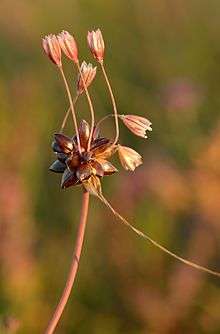Allium oleraceum
| Field garlic | |
|---|---|
 | |
| Allium oleraceum | |
| Scientific classification | |
| Kingdom: | Plantae |
| Clade: | Angiosperms |
| Clade: | Monocots |
| Order: | Asparagales |
| Family: | Amaryllidaceae |
| Subfamily: | Allioideae |
| Tribe: | Allieae |
| Genus: | Allium |
| Species: | A. oleraceum |
| Binomial name | |
| Allium oleraceum L. 1753 not Des Moul. 1840 | |
| Synonyms[1] | |
|
Synonymy
| |

Allium oleraceum (field garlic) is a Eurasian species of wild onion. It is a bulbous perennial that grows wild in dry places, reaching 80 cm in height. It reproduces by seed, bulbs and by the production of small bulblets in the flower head (similarly to Allium vineale). Unlike A. vineale however, it is very rare with A. oleraceum to find flower-heads containing bulbils only.[3] In addition, the spathe in A. oleraceum is in two parts.[3][4]
Distribution
Allium oleraceum is widespread across most of Europe, with additional populations in Turkey and the Caucasus.[5][1] It is sparingly naturalised in scattered locations in North America.[6][7][8]
In the United Kingdom, A. oleraceum is found in dry, grassy places, usually steeply sloping and calcareous soils, and on open sunny banks in river floodplains. It favours altitudes of 0-365 m. A. oleraceum is scattered throughout England and very scattered in Wales, Scotland and Ireland (Stace, 1997). Erosion of coastal areas leads to a reduction in the available habitat for this species, leading to population declines.[9]
- formerly included[1]
Allium oleraceum subsp. girerdii, now called Allium oporinanthum
Agriculture
This plant prefers partial or full exposure to sunlight. Allium oleraceum tends to grow in slightly moist, heavy clay-like soil, although it will grow just fine in other soils. This plant spreads quickly, much like a weed, and can be difficult to get rid of.
See also
References
- 1 2 3 Kew World Checklist of Selected Plant Families
- ↑ 1885 Illustration Original book source: Prof. Dr. Otto Wilhelm Thomé Flora von Deutschland, Österreich und der Schweiz 1885, Gera, Germany
- 1 2 The Reader's Digest Field Guide to the Wild Flowers of Britain p.382.
- ↑ Linnaeus, Carl von. 1753. Species Plantarum 1: 299.
- ↑ Altervista Flora Italiana
- ↑ Flora of North America v 26 p 238, Allium oleraceum
- ↑ BONAP (Biota of North America Program), floristic synthesis, Allium oleraceum
- ↑ Gleason, H. A. & A.J. Cronquist. 1991. Manual of the Vascular Plants of Northeastern United States and Adjacent Canada (ed. 2) i–910. New York Botanical Garden, Bronx.
- ↑ UK Genetic Resources for Food and Agriculture (GRFA).
.jpg)